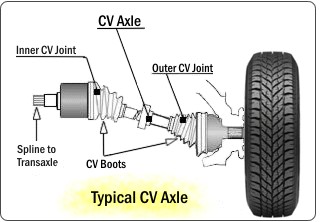CV, or Constant Velocity, axle shafts are crucial components in front-wheel-drive vehicles. They transfer power from the transmission to the wheels while allowing for steering. This article delves into the mechanics of Cv Axle Shafts, differentiating them from drive axles and drive shafts.
What is a CV Axle Shaft?
A CV axle shaft’s primary function is to transmit power from the transaxle to the wheels while accommodating steering movements. The “constant velocity” aspect ensures consistent power delivery regardless of the wheel’s angle. This consistent speed is maintained by the intricate design of the CV joint, allowing the outer section to rotate at the same speed as the inner section, even when turning. This differs from U-joints, where speed fluctuates as the yokes rotate.
CV Axle Shaft vs. Drive Axle
While both relate to power transmission, there’s a key distinction. A drive axle is a broader term referring to the component connecting the differential to the wheel, typically housed within an axle housing. CV axles are a specific type of drive axle used in front-wheel-drive vehicles. Drive axles can be found in both front and rear-wheel-drive vehicles. In essence, a CV axle is a drive axle, but not all drive axles are CV axles. A traditional drive axle is a solid component, often found in rear-wheel-drive vehicles with a solid rear axle.
CV Axle Shaft vs. Drive Shaft
Unlike CV axle shafts and drive axles, drive shafts are found in rear-wheel-drive and four-wheel-drive/all-wheel-drive vehicles. They transmit power from the transmission or transfer case to the differential. This crucial component allows for power transfer even as the axle housing moves vertically during driving. Front-wheel-drive vehicles lack drive shafts because the transaxle contains the entire powertrain unit, eliminating the need for a separate drive shaft. A key feature of the drive shaft is the slip yoke, allowing for variations in distance between the transmission and differential as the vehicle moves. The terms “drive shaft” and “prop shaft” are interchangeable.
Conclusion
Understanding the distinctions between CV axle shafts, drive axles, and drive shafts is crucial for vehicle maintenance and repair. CV axle shafts are vital for front-wheel-drive functionality, ensuring smooth power delivery during steering. Drive axles are a broader category encompassing various components connecting the differential to the wheels. Finally, drive shafts play a crucial role in rear-wheel-drive and four-wheel-drive/all-wheel-drive systems by transmitting power to the differential. Each component plays a distinct role in a vehicle’s drivetrain.

